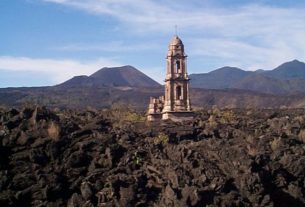By the 13th century the entire region, then called the Valley of Anahuac, was occupied by assorted rival city-states. Among the last to arrive on the scene was the nomadic tribe of the Mexica (pronounced may-SHEE-ka), more commonly known as the Aztecs, who ended a long migration from their northern homeland, Aztlan, by settling in the Valley marshlands.
The Aztecs considered themselves the chosen people of the sun and war god Huitzilopochtli. After coming upon an eagle perched on a cactus devouring a snake, a sign foretold in ancient tribal prophecy, the Aztecs founded Tenochtitlan, their capital, on an island in Lake Texcoco. They sustained themselves there for half a century by acting as mercenaries for the mighty Tepanecs of Azcapotzalco, but eventually rose up against their rulers, effectively seizing power over the valley.
Tenochtitlan soon became the capital city of a vast empire, a magnificent metropolis graced by great canals, colorful markets places and temples galore. It was inhabited by highly organized society, ruled by a king and dominated by a noble class of priests and tax collectors, a warrior elite and an active, vital merchant class. The state engaged in war with other states for two express purposes: to exact tribute for maintaining the society and to capture prisoners for sacrifice to the gods.
According to Aztec belief, their world existed under the fifth sun, four previous ones having been destroyed by various cataclysms. Thus a chief mission of the culture was to keep the sun rising, a task accomplished by appeasing Huitzilopoctli with abundant offerings of human hearts. Following the calendar systems adopted from earlier civilizations and keeping a watchful eye on the heavens, the Aztecs held a dizzying array of religious observations in honor of their many gods, the Plumed Serpent Quetzalcoatl and the rain god Tlaloc, being among the most important.
In the 15th century the Aztecs formed the Triple Alliance with the states of Texcoco and Tlacopan. The joint armies were sent east to wage war against Tlaxcala and Huejotzingo. When the victorious warriors returned to Tenochtitlan in 1487 they brought 20,000 captives to be sacrificed for the dedication of the Great Temple built to honor both Huizilopochtli and Tlaloc.
During the reign of Moctezuma II the Aztec Empire was at its height, extending throughout most of central and southern Mexico. The appearance of a comet in 1517 was one of several portents of the empire’s bitter end. In the spring of the year Ce Acatl (1519) a courier reported to Moctezuma the news that bearded white men bearing crosses had landed on the shores of the Gulf of Mexico. To the sensitive and superstitious Moctezuma that could only mean one thing– Quetzalcoatl had returned as promised.

